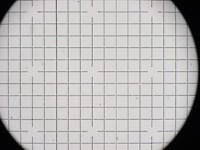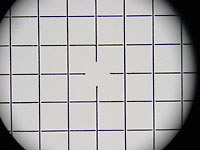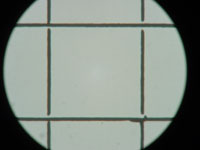Trials using an external zoom digicam (Sony
S75) on a
microscope,
with a reversed SLR lens as a relay lens.
by Dave Walker, UK
Main
article is here.
This is a supplementary page.
1) More
detailed notes on use of the reversed SLR lens specifically with the
Sony S75 and LOMO pre-DIN optics.
2)
Test images of 0.2 mm grid for optical quality check at low power.
1) More
detailed notes on use of the reversed SLR lens with the
Sony S75 and LOMO pre-DIN optics and one modern DIN achromat.
Sony S75:
Manually set as
follows: 20 cm fixed focus gave the least vignetting if
an eyepiece was used, infinity focus gave the least if used without an eyepiece. Max aperture (f2.5) at 3x optical
zoom (although can be stopped down to ca. f4 without extra vignetting). Sharpness set to '0', jpeg fine. A manual camera white balance was taken on the
lamp. (For low-mid power mags. I use a 75W
photoenlarger bulb in an old enlarger head with a field
diaphragm. Camera exposures with this lamp were typically in
the 1/30 - 1/100th of a second range.) The +/- 0.3 - 2.0 stops exposure
override button on the Sony S75 is useful for
adjusting exposure.
The objective working distance was a little higher than for
visual to project a focussed image on the LCD screen. The ca. three minutes before
auto-shutdown of the S75 on batteries is annoying, using the mains adaptor can avoid
this. The self-timer is also on an
independent button and was used to minimise
vibration.
LOMO optics:
For my two most used
objectives, the 3.5x and 9x LOMO pre-DIN planachromatic
objectives, they worked well without an eyepiece for minimal vignetting
and max. field of view. When used with an eyepiece the
compensating 'K' LOMO eyepieces worked best; the non-compensating type gave marked chromatic
aberration with the photo set-up. This eyepiece choice
is the
reverse of what works best for visual work, for reasons I
don't fully understand.
Two LOMO pre-DIN apo's
(10/0.3, 20/0.65) worked best with the 'K' eyepieces but some chromatic aberration was
observed in outer third of field. The 20/0.40 and 40/0.65 LOMO pre-DIN achro's, weren't too fussy but worked best without an eyepiece.
For 20x objectives
and above a small
hot spot was seen at field centre with an eyepiece.
No evidence of Newton's rings has been seen to date, which has been observed
with some digicams. A field stop was useful at higher mags to stop tube flare when
an eyepiece wasn't used (a 'C' mount adaptor with a 12 mm stop was inserted where
the eyepiece usually rests).
2) Test images of 0.2
mm grid for optical quality check at low power.
A good
subject for first assessing experimental
photo set-ups at lower powers is an eyepiece reticle grid on a microscope slide. The typical 0.2 mm
grid is useful for spotting loss of field flatness, geometrical distortion and any chromatic aberration of the black lines
is
easier to spot. From the results, the reversed SLR lens is a good relay lens and match for the
LOMO objectives tried, without undue aberrations beyond that expected for
these objectives. The author borrowed a modern DIN achromat to see
how it performed, and it also seemed a good match to the reversed standard
lens as a relay lens.
Test images. 0.2 mm grid. Small images are resize of full
frame.
Click each image for 'out of the camera' 2048x1536 image resized
to 800x600.
|
Reversed 50/1.8
Nikkor SLR series E lens as relay lens.
No eyepiece. 12
mm field stop at eyepiece position. This stop wasn't essential
at low to mid powers, it slightly increased light fall off within
vignetting border, so for pictures in main article the stop
wasn't used.
|
|

|
| Above: 3.5/0.10 LOMO pre-DIN planachro.
|
|

|
| Above: 9/0.20 LOMO pre-DIN planachro.
|
|

|
|
Above, JNOEC 10/0.25 modern Chinese DIN achromat.
Borrowed
from my brother who has found it to be a very
fine objective for visual work.
|
|

|
|
Above, LOMO pre-DIN 10/0.30 apochromat. Compensating
LOMO K7x eyepiece.
|
Return
to main article.
Comments to the author
Dave Walker
are welcomed.
© Microscopy UK or their contributors.
Published
in the August 2003 edition of Micscape.
Please report any Web problems or offer general comments
to the Micscape
Editor.
Micscape is the on-line monthly magazine of the Microscopy
UK web
site at Microscopy-UK
© Onview.net Ltd, Microscopy-UK, and all contributors 1995 onwards. All rights
reserved. Main site is at www.microscopy-uk.org.uk with full mirror at www.microscopy-uk.net.



